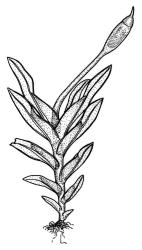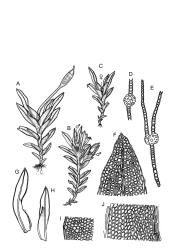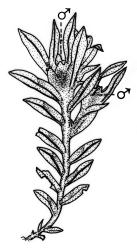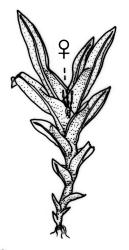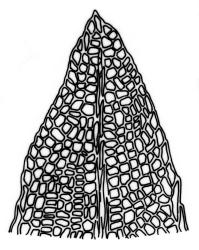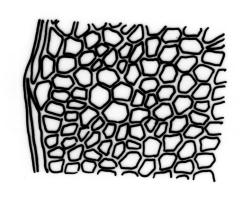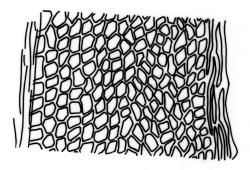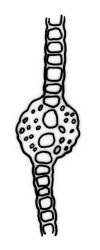Non Fissidens anisophyllus sensu Sainsbury 1955.
The name F. anisophyllus has been misapplied to specimens of F. blechnoides, initially by H.N. Dixon, the author of the species. No specimens other than the type are mentioned in his protologue (Dixon 1912). In BM-Dixon there are a further seven specimens identified as F. anisophyllus by Dixon, all collected subsequent to the publication date. Two of these (also collected by W. Gray at Mauriceville) are similar to the type. A fourth Gray specimen, from Mt Bruce (c. 8 km NW of Mauriceville), is annotated by Dixon as "a better developed form of F. anisophyllus than the type; taller, leaves more numerous, wider, more falcate when dry; but structure scarcely different". This specimen is referable to F. leptocladus. Of the remaining specimens labelled F. anisophyllus by Dixon, three are F. blechnoides, at that time undescribed. The incorrect application of the name F. anisophyllus was perpetuated by G.O.K. Sainsbury, who almost certainly never saw type material but had specimens named for him by H.N. Dixon. The description and notes provided by Sainsbury (1955, pp. 50–51) are thus unreliable.
Plants 2–6 mm, loosely gregarious. Stems occasionally branched. Leaves in 4–10 pairs, not overlapping at mid stem, patent, plane when moist, lightly crispate when dry, oblong-lanceolate, 0.8–1.4 × 0.20–0.25 mm; apex acute; laminae unistratose; vaginant laminae ½–⅔ leaf length, partially closed to closed; dorsal lamina failing above leaf insertion, tapered to its base; margins entire on dorsal, apical and vaginant laminae, serrulate towards the leaf apex; marginal cells distinct in 1–2 rows, prosenchymatous, forming a unistratose border that is variably developed, but usually present throughout the vaginant laminae and to some extent on dorsal and apical laminae; cells of apical and dorsal laminae quadrate to hexagonal, smooth, non-bulging, thin-walled, (4.5–)6.0–10.5(–15.0) × (4.5–)6.5–10.5(–12) µm. Costa percurrent, or failing a few cells below the leaf apex, bryoides-type in cross-section.
Dioicous. Perichaetia terminal; perichaetial leaves longer than vegetative. Perigonia terminal on main stem or axillary shoots; male plants of similar size to female. Setae 1.5–2.0 mm; capsules erect, symmetric, 0.3–0.5 mm; operculum obliquely rostrate from a conic base, ¾ to equal the length of theca. Peristome bryoides-type; teeth with long-columnar papillae on the adaxial trabeculae below the bifurcation, 35–40 µm wide at base. Calyptra smooth, cucullate. Spores 10–14 µm.
Dixon 1912, fig. 21, 42–45; Beever 1996, figs 4–5; Beever et al. 2002, p. 14, figs 1–6.
Fissidens anisophyllus differs from F. leptocladus in its generally shorter plants (2–6 mm vs 3–15 mm), laminal cells less bulging and thinner-walled (and hence more pellucid), more variable in size, and generally larger: (4.5–)6.0–10.5(–15.0) × (4.5–)6.5–10.5(–12) µm in F. anisophyllus vs (5.0–)6.0–7.5(–9.0) × 6.0–9.0 µm in F. leptocladus.
NI: Wellington (Ihuraua, Mauriceville, Mt Bruce, Palmerston North, Tauweru River).
Endemic.
Fissidens anisophyllus is known from only c. 6 collections, but could easily be passed over as small F. leptocladus. All specimens were on soil; from rural roadside and river banks, and from shaded lawn in an urban park. At the last mentioned site, in Palmerston North, the Fissidens was growing mixed with Didymodon australasiae. Elevations range from c. 20 to 200 m, all in the southern part of the Wellington L.D.
The species is classified as "Data Deficient" in the N.Z. Threat Classification System (Glenny et al. 2011).
An account of F. anisophyllus in N.Z. was given by Beever (1996).



